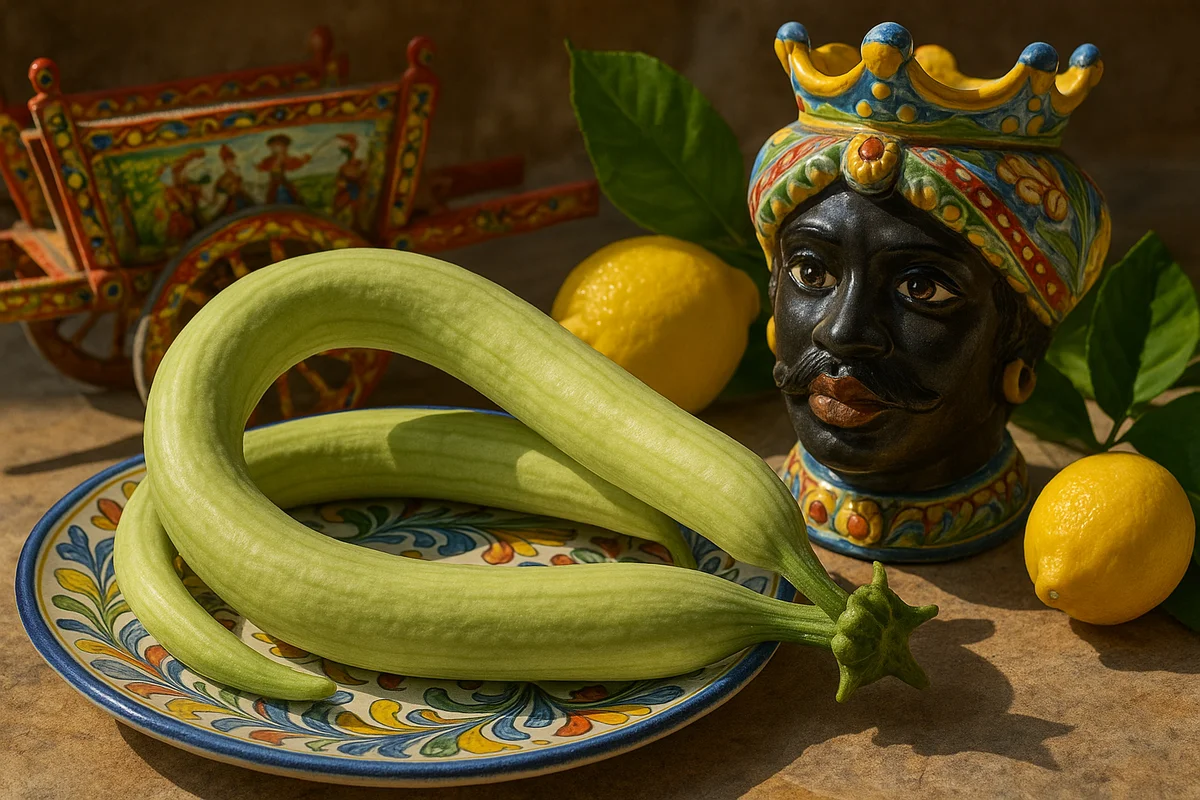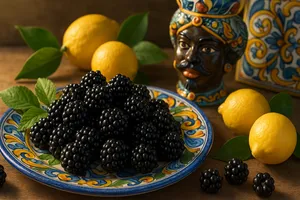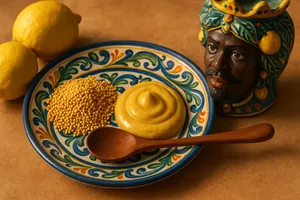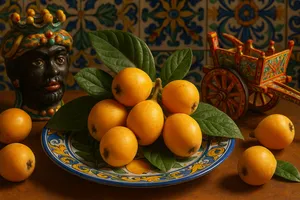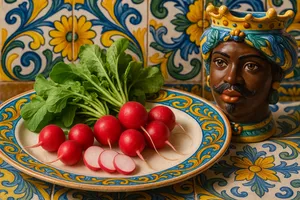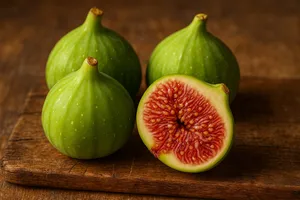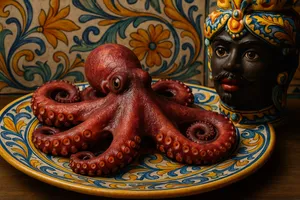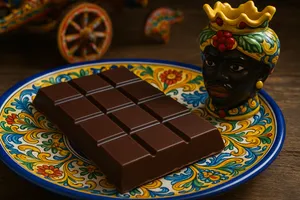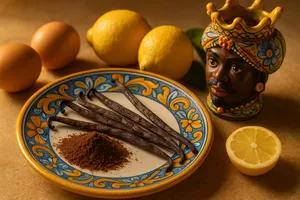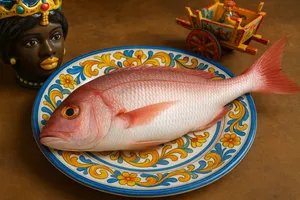Overview
The snake gourd, known in Sicilian as cucuzza longa, is a distinctive gourd (botanically Lagenaria siceraria or Lagenaria longissima, family Cucurbitaceae) characterised by extremely long fruits (they can exceed 1–2 metres), slender, cylindrical and curved like a serpent (hence the English name), with smooth pale green skin and soft, delicate white flesh. In traditional Sicilian cooking, cucuzza is a common summer vegetable, grown in family gardens and used while young (still tender, around 30–60 cm long) for simple but flavourful dishes: cucuzza soup (with tomato, onion and potatoes), frittatas, fried cucuzza, pasta with cucuzza, side dishes. It has an exquisitely delicate, slightly sweet flavour and a soft texture that absorbs seasonings well. It is a versatile, low-calorie, refreshing vegetable, perfect for the Sicilian summer. Mature cucuzza (left to grow until the skin hardens) is not edible, but the dried shell was (and is) used as a container, water flask or utensil; candied peel becomes “zuccata”, a traditional ingredient in Sicilian confectionery.
Cucuzza represents Sicilian rural wisdom: a robust, productive plant that grows abundantly with little care, versatile (young for cooking, mature for other uses), economical. In traditional Sicilian gardens, pergolas of cucuzza offered cool shade and continuous fruits throughout the summer. Cucuzza evokes the Sicilian summer, family gardens where long gourds hung from pergolas like green serpents, the simplicity of humble yet nourishing dishes (a bowl of cucuzza soup with bread was a complete meal), and the ability to create goodness from modest ingredients. In collective memory, cucuzza is a symbol of authentic rural cuisine, seasonality and the simple food that sustained entire families.
Characteristics
Young cucuzza (the edible stage) measures 30–80 cm (it can exceed 1 metre but is best eaten smaller for tenderness), 5–8 cm thick, cylindrical, curved, with smooth pale green skin. Its inner flesh is white and spongy, with small tender seeds (if very young; otherwise the seeds harden and must be removed). It has an exquisitely delicate, slightly sweet, almost neutral flavour. Its texture is soft and cooks quickly.
Mature cucuzza (left to reach full ripeness) develops a hard, woody, light brown skin. At this stage it is not edible (too tough and bitter), but the shell becomes a natural container: once emptied and dried, it is waterproof and light, traditionally used as a water flask (“cucuzza d’acqua”), vessel or tool.
Cultivation
Cucuzza is a vigorous climbing plant that requires support: traditionally grown on pergolas, trellises or nets. It grows rapidly in summer and produces fruits continuously from June to September. It needs full sun, fertile well-drained soil and regular watering (as with all cucurbits). A single plant can produce dozens of fruits in one season.
In Sicilian gardens, the cucuzza pergola is classic: it provides cool shade to sit under, the fruits hang within easy reach, and the plant is both decorative and productive. It is a traditional family crop; every home with a garden had at least one cucuzza plant.
Harvest
Cucuzza is harvested young, when it is 30–60 cm long (up to 80–100 cm), still tender. It is cut from the stalk with a knife or scissors. The fruits grow quickly: they should be checked every 2–3 days and picked at the right moment. If left too long, they become too large and tough, with large seeds (less appealing but still usable if the seeds are removed).
Seasonality
Cucuzza is a summer vegetable: available from June to September, peaking in July–August. It is a fresh vegetable to be eaten in season, with a short shelf life (it keeps only a few days). It is (and was) a symbol of the Sicilian summer.
Use in Sicilian cuisine
Cucuzza soup
The most classic and beloved preparation. The cucuzza, cut into pieces, is stewed with fresh tomato or passata, onion, potatoes, basil and oil. It becomes a thick, comforting soup, served with bread or pasta (ditalini, puntine). It is a humble yet nourishing and flavourful dish that once fed farming families.
Pasta with cucuzza
A variant of the soup: cucuzza cooked with tomato as a sauce for short pasta (ditalini, tubetti, maccheroncini). It is a simple and delicious summer first course.
Fried cucuzza
Pieces of cucuzza, floured and fried in oil. They become golden, soft inside and slightly crisp outside. Served hot with salt, excellent as a side dish or starter.
Cucuzza frittata
Thinly sliced cucuzza sautéed with onion, mixed with beaten eggs and cooked until set. A soft, flavoursome frittata, a quick main dish.
Baked cucuzza
Pieces of cucuzza arranged in a baking dish, seasoned with tomato, garlic, basil, breadcrumbs and oil, then baked until gratinated. Soft, tasty and light.
Stuffed cucuzza
A traditional preparation: pieces of cucuzza filled with a stuffing (minced meat, breadcrumbs, cheese), cooked in a tomato stew. A more elaborate, festive dish.
Cucuzza salad
Very young cucuzza sliced finely (mandoline), marinated with salt, lemon, oil and mint. Eaten raw as a refreshing salad. Not extremely widespread but possible with very young, tender cucuzza.
Preparation
To prepare cucuzza:
1. Wash well.
2. Trim the ends.
3. Peel if the skin is tough (young skin is often thin and may be left on), or peel partially in strips.
4. Cut into rounds, pieces or cubes depending on the recipe.
5. If the seeds are large and hard, remove them (cut the cucuzza lengthways and scoop them out with a spoon). If the seeds are small and tender, they may be left in.
Cucuzza cooks quickly (10–15 minutes) thanks to its soft, watery flesh.
Cucuzza vs standard courgette
Cucuzza (snake gourd, Lagenaria): Very long, curved, pale green skin, white spongy flesh, exquisitely delicate flavour. A specific traditional Sicilian vegetable. A vigorous climbing plant.
Standard courgette (Cucurbita pepo): Short (15–25 cm), straight, cylindrical, with dark or light green striped skin, pale green flesh and a slightly stronger flavour. A common courgette grown everywhere. A bushy or lightly climbing plant.
Botanically they belong to different genera (Lagenaria vs Cucurbita) but both are cucurbits. In cooking they are used similarly, but cucuzza is more delicate and watery.
Storage
Fresh cucuzza keeps in the refrigerator for 3–5 days, in a perforated bag or the vegetable drawer. It does not store for long (like standard courgettes). It should be eaten fresh.
Cucuzza can be frozen: cut into pieces, blanched briefly, drained and frozen in bags. It keeps for several months and is suitable for soups and sauces (the texture will be softer).
Nutritional properties
Cucuzza is a low-calorie vegetable: 100 g provide about 15–20 calories. It is around 95% water, contains carbohydrates (3–4 g), fibre (1 g), vitamins (especially vitamin C and some B vitamins) and minerals (potassium, magnesium, calcium). It has very little fat or protein.
It is a refreshing, hydrating, light vegetable, ideal for low-calorie diets. Its flesh is easily digestible. It has no extraordinary medicinal properties but contributes to hydration and micronutrient intake.
Benefits
- Hydration: its high water content helps with hydration in summer.
- Lightness: very few calories, suitable for slimming diets.
- Digestibility: soft, easy-to-digest flesh.
- Fibre: supports intestinal regularity.
- Versatility: suitable for many preparations.
Cucuzza in Sicilian tradition
Cucuzza has a long history in Sicily. Lagenaria is native to Africa and is one of the first plants domesticated by humankind (10,000 years ago). It reached the Mediterranean long ago (probably with the Greeks or earlier) and became common in Sicily for its double utility: food (young fruits) and utensils (mature dried fruits used as containers).
In Sicilian rural gardens, the cucuzza pergola was an architectural and functional element: providing shade, food and beauty. It was a place where families sat on summer evenings, cooling beneath the leaves while long green fruits hung down like decorations.
Cucuzza soup was a daily summer dish, inexpensive and nourishing, feeding large families with few ingredients: cucuzza, tomato, onion, potatoes, bread. It was the people’s food, wasting nothing and making the most of family gardens.
Mature cucuzza provided precious natural containers before the age of plastic: flasks for carrying water in the fields, vessels for storing seeds, pulses or salt. Once emptied and dried, the shell was waterproof, light and durable. Some cucuzza containers were decorated, engraved, becoming items of folk art.
Other traditional uses
Cucuzza as a water flask
The mature dried cucuzza (“cucuzza d’acqua”) was the traditional Sicilian water flask: it was emptied, dried, pierced and stoppered with cork. It was waterproof, kept water cool (evaporation through the porous walls cooled the contents) and was long-lasting. It could be seen hanging from the belts of farmers, shepherds and travellers.
Musical instruments
In some cultures (Africa, South America), dried Lagenaria is used for musical instruments: maracas, string instruments (as resonant bodies). It is not a widespread Sicilian tradition but there was craftsmanship dedicated to making sound objects.
Utensils
Spoons, ladles and bowls made from cut dried cucuzza. It was humble but functional folk craftsmanship.
Curiosities
The term “cucuzza” (or “cocozza” in other southern Italian regions) probably derives from the Latin “cucutia” or the Greek “kolokytha” (gourd), ancient words for cucurbits. In Sicilian, “cucuzza” refers specifically to the long Lagenaria, while “zucca” (zampa, zuccàru depending on variety) refers to other gourds.
In Sicilian popular speech, “aviri 'na cuccuzza pi testa” (to have a cucuzza for a head) means being foolish or empty-headed. It is a humorous expression comparing an empty head to an emptied cucuzza (light, hollow).
Lagenaria siceraria is one of the few plants domesticated before organised agriculture: it was grown mainly for containers (non-food use), essential for transporting and storing water and food in pre-ceramic societies. It is an example of a plant that changed human history.
There is archaeological evidence of cucuzza (Lagenaria) in human sites dating back 13,000 years in Asia and 10,000 years in Africa. Some scholars suggest that Lagenaria seeds crossed oceans by floating (mature gourds float), reaching different continents naturally, later adopted by local populations. It remains a fascinating debate on pre-Columbian diffusion.
In Sicily, there was a tradition of decorating dried cucuzza with engravings, pyrography and painting. They became items of folk art, gifts and souvenirs. Some artisans still preserve this craft, creating artistic pieces from cucuzza.
Cucuzza features in Sicilian proverbs and sayings: “Cu' nasci tunnu, 'un pò moriri quatratu” (He who is born round cannot die square), often said while holding a curved cucuzza (those with innate traits cannot completely change).
An old saying goes: “‘A cucuzza is better than meat when it is hot”, referring to the fact that in summer, light, fresh, watery foods like cucuzza are more appealing and wholesome than heavy meats.
Today cucuzza is less cultivated and consumed than in the past (replaced by modern courgettes, changing tastes, urbanisation), but it remains a traditional vegetable appreciated by those who know authentic Sicilian cooking. Some farmers’ markets, organic growers and urban gardens are rediscovering cucuzza as a resilient, productive heritage vegetable linked to tradition.
In some southern Italian regions (Calabria, Puglia, Campania), Lagenaria is called “cocozza”, “cucuzza”, “wine gourd” (because the containers made from it were used to carry wine), “Indian gourd”. It is a traditional southern Italian vegetable with local preparation variants.
The cucuzza plant is an example of extraordinary rapid growth: in optimal conditions, its vines grow several centimetres per day, and the fruits lengthen visibly. It is a plant that fascinates for its vigour and productivity, a symbol of vegetal abundance.

